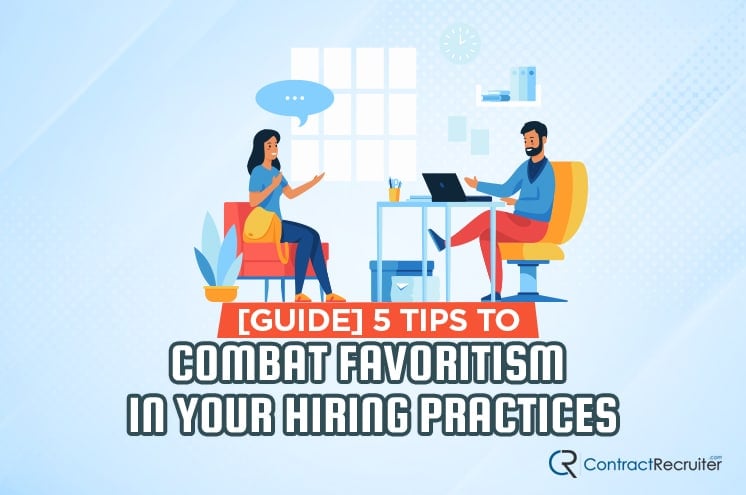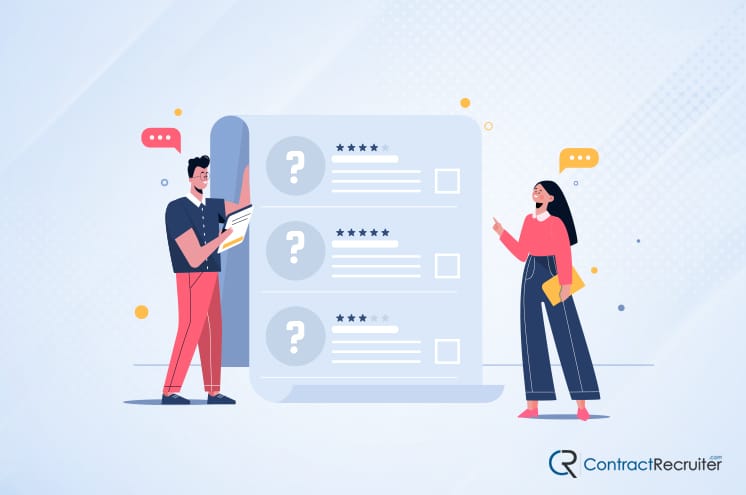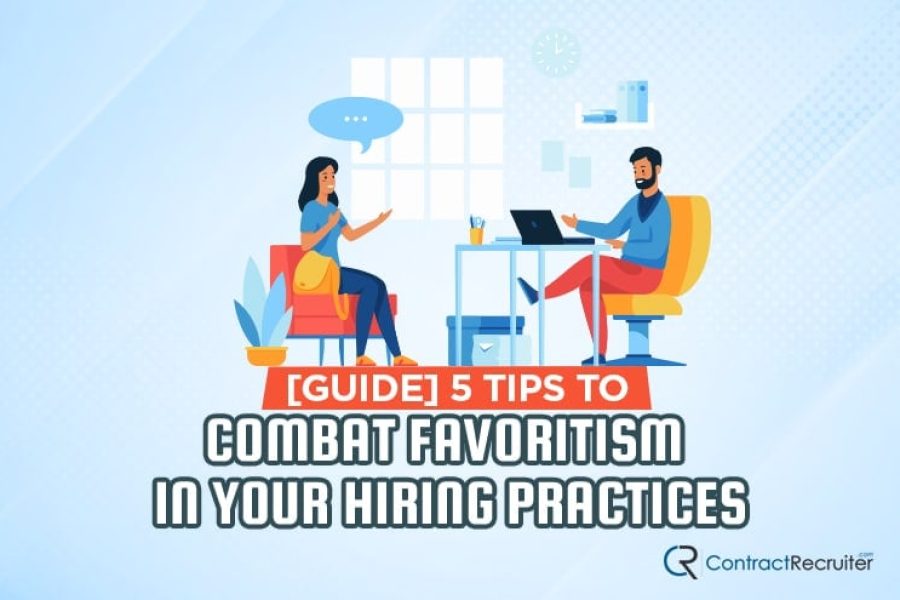

Hiring teams are likely well aware that it is illegal and unethical to discriminate against candidates based on “race, color, national origin, sex, religion, age, or disability.” However, it’s also essential to ensure that your hiring practices aren’t allowing favoritism to guide staffing decisions in your workplace.
Favoritism in hiring certainly can cross into the realm of illegal. For example, research has found that men are more likely to hire other men, while women are more likely to hire other women. This points to the reality that favoritism and its related discrimination might be all too common in recruiting and hiring.
At the same time, favoritism doesn’t have to be unlawful to impact your organization negatively. Factors as seemingly harmless as preferring a candidate because you belonged to the same fraternity or sorority or share common hobbies can mean that you aren’t hiring the most qualified person for the job.
Let’s take a look at how you can combat favoritism in your hiring practices to ensure that you are always selecting the best candidate for the position.
What Is Favoritism in Hiring?
Favoritism is precisely what it sounds like– favoring an individual for reasons that don’t have to do with their abilities and experience, but instead due to some extraneous feature. That might have to do with a person’s likes and dislikes, membership in a favored group, or another reason entirely.


Organizations should be motivated to eliminate favoritism in hiring individuals and in giving out promotions.
- One specific type of favoritism is known as cronyism. This is when a person is favored because they belong to a network of insiders.
- Another, more narrow kind of favoritism is nepotism. In hiring, nepotism occurs when someone is hired because they are related to someone in the organization rather than based on their skills, abilities, and experience.
Cronyism and nepotism are two types of in-group favoritism, which means that a person favors someone else for being a member of a group they belong to. People can also show out-group favoritism, which is when you favor someone who belongs to a group you don’t belong to.
An example of out-group favoritism might be hiring someone because they went to an Ivy League school you have always held in high regard, even though you didn’t attend the school.
Why Is It Important to Avoid Favoritism in Your Hiring Process?
Playing favorites can be a problem in the office, but it’s also important to avoid during the hiring and recruiting process.
One of the most apparent reasons why combatting favoritism in hiring is important is that it can hurt your organization. After all, if you favor someone in the hiring process for reasons that don’t have to do with their ability to perform the role, your company won’t be gaining the most capable employee for the position.


Favoritism in the hiring process can add up over time to cause issues in your company culture as well. For example, if your existing employees believe someone was hired for reasons other than their qualifications for the position, it can lead to resentment, bitterness, and other negative cultural attributes.
It’s also essential to avoid favoritism when promoting employees. If it is clear to your team that someone received a promotion because they are your close friend, for example, rather than their ability to fulfill their necessary duties, it can negatively affect motivation, productivity, morale, and the culture as a whole.
Is Favoritism in Hiring Illegal?
Depending on why an individual is favored in the hiring process, it may or may not be illegal. For example, hiring a less-qualified candidate because they like the same sports team as you isn’t unlawful, though some could consider it unethical. However, hiring one candidate over another because of protected characteristics is illegal.
An employer cannot make an employment decision because of an individual’s race, religion, color, sex, national origin, disability, age, or genetic information.
Illegal favoritism stretches beyond your actual hiring decision, too. Employers cannot publish job advertisements that discourage people from applying or show a preference toward certain people based on the protected characteristics listed above.
For example, it might technically be illegal to publish a job post seeking “recent college graduates” for a position, even if that seems relatively harmless. That is because people over the age of 40 (as this is how the government distinguishes the protected characteristic of age) might be dissuaded from applying.
It’s essential to avoid favoritism when recruiting candidates as well. It is similarly illegal to discriminate against people based on a protected characteristic in the recruiting process.


In the application and hiring process, an employer also cannot discriminate based on a protected characteristic, and their hiring decisions cannot be based on assumptions or stereotypes due to a person’s possession of one of these protected characteristics.
Any tests you require as a part of your job application process must not exclude anyone based on these protected characteristics, and the test must be necessary and related to the job.
Employers are also required to provide accommodations for individuals with a disability if they are necessary to apply for the job (so long as significant expense or difficulty isn’t caused to the employer.)
These protections apply to job referrals, assignments, promotions, pay and benefits, discipline, and discharge.
By favoring an employee because they aren’t in a protected class, you are likely breaking the law. For example, if you choose a female candidate over a more qualified male candidate because you assume that the open position is a woman’s job, you are discriminating against the male candidate.
5 Tips to Combat Favoritism in Your Hiring Practices
To make sure that the most qualified candidate is hired for any open positions at your organization, it’s essential to work to combat favoritism in your recruiting and hiring process. Here are five ways to ensure that preferential treatment isn’t impacting your hiring decisions.
1. Rewrite Your Job Descriptions
One of the first places you can begin combatting favoritism in your hiring practices is through your job descriptions. The application pool you receive can be significantly impacted by even the subtlest word choices, so it’s worth taking the time to ensure that no candidates are dissuaded from applying because of how the description is written.


For example, using certain words in a job post can come across as more masculine to job seekers, potentially leaving women to feel as though they don’t belong in the work environment to the extent that they don’t apply. Words that typically dissuade women from applying to a job include adjectives such as “determined” and “competitive.”
On the other hand, words like “cooperative” and “collaborative” tend to draw more women than men and might deter men from applying.
Are you interested in learning how to improve generational diversity in your workplace? If so, check out these five ways to confront age bias.
2. Institute Blind Hiring Practices
Another way that you can reduce favoritism in the hiring process is by instituting blind hiring and recruiting practices. Blind hiring involves anonymizing the resumes and applications of candidates so that recruiters can focus only on their experience and skills rather than other factors that could lead to favoritism or discrimination.
When you follow a blind recruitment process, several common identifying details can be left out of resumes and applications.


Whether you have a third-party anonymize these documents or you use a blind recruiting software, some of the information that can be removed from resumes and applications include:
- Gender
- Ethnic background
- Names
- Age
- Education
- Personal interests
A person’s name can indicate many pieces of identifying information, such as their gender, nationality, and ethnic background. Even if the indication is false (for example, a person with a name that sounds female but is actually male,) favoritism or discrimination could arise, even unconsciously.
Leaving out the specific educational institution where a person received their degree can also reduce favoritism in the hiring process. For example, a recruiter might feel a sense of camaraderie with someone that attended their alma mater and show favoritism towards them during the process.
Most hiring teams would never dream of explicitly being discriminatory or showing favoritism, but it’s essential to understand that this can be very subtle. For example, if a person’s interests are listed, a hiring team member might favor them because they share a similar hobby without even realizing it.
3. Standardize Your Interview Process
While unstructured interviews are often the preference for hiring teams, research has found that they are “among the worst predictors of actual on-the-job performance.” In this type of interview, the goal is for a candidate’s skills and experience to unfold through a natural conversation rather than being guided by defined questions.
On top of being less effective as a hiring practice, unstructured interviews also open up the process to potential favoritism. The person conducting the interview might be more likely to favor someone they feel they have a lot in common with, for example, over someone else with more experience with whom they didn’t “click” with as much.


Implementing standardized interviews can allow you to minimize bias and focus only on factors that directly impact candidate performance. Ideally, the interview process can be another independent data point that can be incorporated into the hiring decision.
4. Have Candidates Complete a Work Sample Test
Another way to remove potential bias that might lead a hiring team to favor one candidate over another is by including a work sample test. This test mimics the type of work expected of the candidate within the role. By having a standardized test for all candidates, you can weigh out their performance against one another in a way that doesn’t incorporate non-related factors.


If the position that you’re hiring for is customer-facing or otherwise requires high levels of interpersonal skills, you might find that incorporating likability as a measurable factor could be helpful.
Studies have revealed that employers tend to hire people that they personally like the best out of the candidate pool, as well as the fact that the initial impression made in the first ten seconds of the interview can lead to a candidate getting hired or not.
While it is natural for people to want to work with others they get along with; it’s important to combat favoritism in the form of natural chemistry or common interests. If you know that likability is a significant part of the role the candidate will be fulfilling, consider grading all of the candidates on a likability score to help control this as a factor and remove it from other parts of the process.
5. Be Self-Aware of Your Existing Biases
Learning about hiring prejudices and how they work is essential in combating favoritism in the hiring process. On top of that, you’ll also want to work to be self-aware of any existing biases you might have.
Even if you work hard to treat everyone equally in the hiring process, favoritism can still emerge when you don’t even realize it. Subtle things can impact whether you favor one candidate over another. For example, something as simple as a person having the same breed of dog as you could unconsciously lead you to give them preference over another candidate.


No one wants to feel like they are unfairly favoring one candidate for reasons that don’t have to do with expected job performance, but the reality is that it’s more common than we’d all like to think.
By having a sense of how you might be swayed to favor one candidate over another, you can keep an eye out for preferential treatment or favoritism during the recruitment and hiring process.
Do you have any questions about how to combat favoritism in your hiring practices? Did we miss any essential tips that you want to contribute? If so, please feel free to leave a comment below, and we’ll get a conversation started on the topic! We love talking about all things recruiting and hiring and would be happy to help you work to eliminate favoritism in your recruiting and hiring process.

